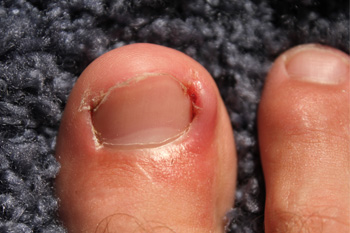 The pain of an ingrown toenail can often be uncomfortable and frustrating, and will typically affect the big toe. It generally occurs when the nails are not trimmed correctly, which may cause the side of the nail to grow downward. Additionally, an ingrown toenail may result from wearing shoes that fit poorly. Common symptoms may include the toe appearing red and tender and in severe cases, a discharge may ooze from the affected and surrounding areas. Many patients will benefit from consulting with a podiatrist who may suggest soaking the foot in lukewarm salt water several times per day. This method will soften the skin which may attain moderate relief. If the toenail becomes infected, surgery may be a necessary treatment option for removal of the nail and the infected surrounding tissue. If you would like additional information about how to prevent or treat ingrown toenails, please consult with a podiatrist
The pain of an ingrown toenail can often be uncomfortable and frustrating, and will typically affect the big toe. It generally occurs when the nails are not trimmed correctly, which may cause the side of the nail to grow downward. Additionally, an ingrown toenail may result from wearing shoes that fit poorly. Common symptoms may include the toe appearing red and tender and in severe cases, a discharge may ooze from the affected and surrounding areas. Many patients will benefit from consulting with a podiatrist who may suggest soaking the foot in lukewarm salt water several times per day. This method will soften the skin which may attain moderate relief. If the toenail becomes infected, surgery may be a necessary treatment option for removal of the nail and the infected surrounding tissue. If you would like additional information about how to prevent or treat ingrown toenails, please consult with a podiatrist
Ingrown toenails may initially present themselves as a minor discomfort, but they may progress into an infection in the skin without proper treatment. For more information about ingrown toenails, contact one of our podiatrists of Sayville Foot Care. Our doctors can provide the care you need to keep you pain-free and on your feet.
Ingrown Toenails
Ingrown toenails are caused when the corner or side of a toenail grows into the soft flesh surrounding it. They often result in redness, swelling, pain, and in some cases, infection. This condition typically affects the big toe and may recur if it is not treated properly.
Causes
- Improper toenail trimming
- Genetics
- Improper shoe fitting
- Injury from pedicures or nail picking
- Abnormal gait
- Poor hygiene
You are more likely to develop an ingrown toenail if you are obese, have diabetes, arthritis, or have any fungal infection in your nails. Additionally, people who have foot or toe deformities are at a higher risk of developing an ingrown toenail.
Symptoms
Some symptoms of ingrown toenails are redness, swelling, and pain. In rare cases, there may be a yellowish drainage coming from the nail.
Treatment
Ignoring an ingrown toenail can have serious complications. Infections of the nail border can progress to a deeper soft-tissue infection, which can then turn into a bone infection. You should always speak with your podiatrist if you suspect you have an ingrown toenail, especially if you have diabetes or poor circulation.
If you have any questions, please feel free to contact our office located in Sayville, NY . We offer the newest diagnostic and treatment technologies for all your foot care needs.
